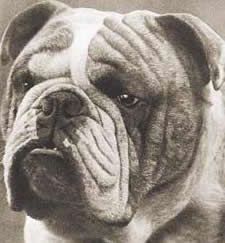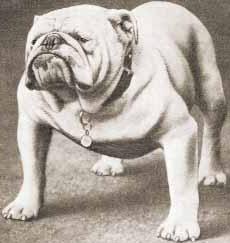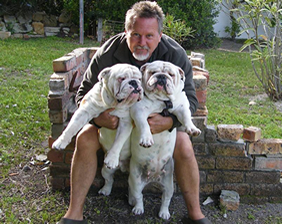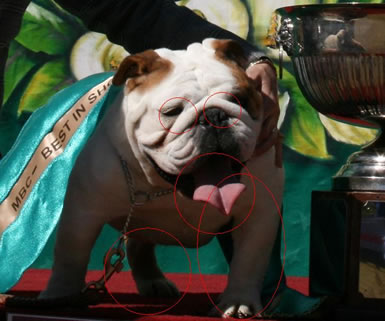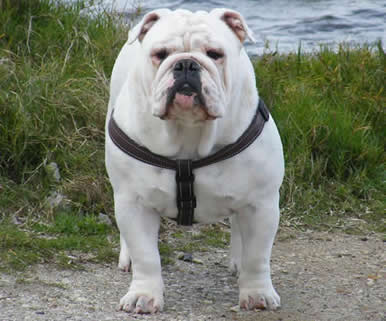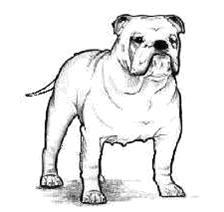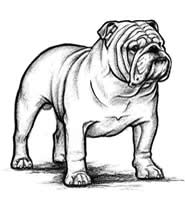
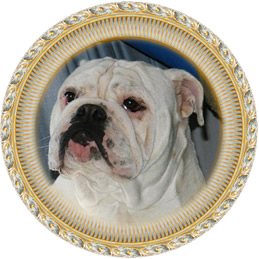 |
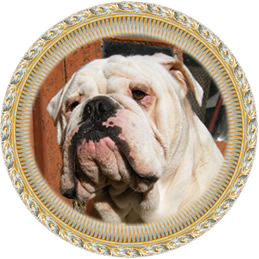 |

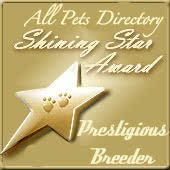
|
|
 |
|
| - We have structured this home-page as
a must read launch page to the unique content to be found
here - |
|
| This website is intended to be unique in its open-mindedness and honesty about the current state of the modern bulldog. More specifically, it is a platform dedicated to the pursuit of the “perfect English bulldog”, in service of bulldogs the world over and a project proceeding under the independent auspices of the Gaia Research Institute, (formally established in 1990), under the directorship of Stuart Thomson. | |
| Whilst the foundation
of this project is entirely evidence based research,
it is also our long-cherished hope to initiate a practical
breeding project to this noble end and so a kennel has
been registered in the name of BYGONES. |
|
| Since our starting point to produce “the perfect English bulldog” is our now coveted ideal of a natural mating and natural birth (assisted only if absolutely necessary but thereby disqualifying that and any subsequent failed attempt), our success is not guaranteed, nor perhaps even likely, but those are our principles in pursuit of said ideal. Perhaps rather surprising to behold, natural bulldog reproduction is actually a rare occurrence in this day and age. | |
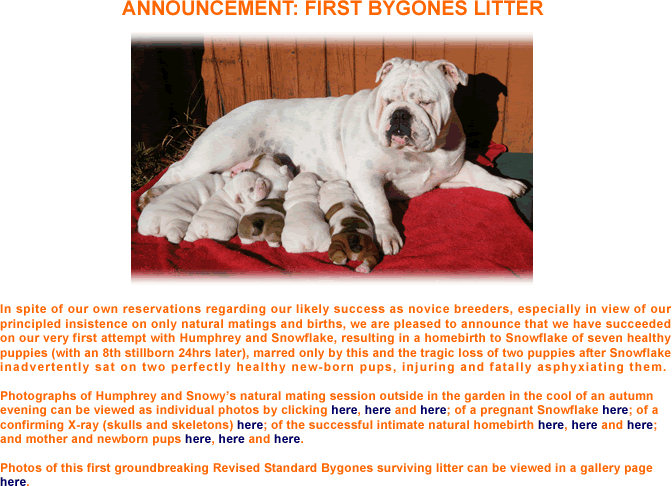 |
|
|
|||||||||||
| Most bulldogs are now routinely conceived
via artificial insemination and Caesarian section, in particular
because the male and female sexual organs are misaligned for their
intended purpose, the dogs generally lack the required health,
fitness and stamina and the size of the head has now widely outgrown
that of the pelvic canal.
These problems originally arose (theoretically) from out-crossing
with the Chinese pug (how English is that?) and thereafter,
including now, almost entirely as a result of line-bred feature-exaggeration
by show champion breeders, to the point that their and show
judge’s interpretations no longer coincide with the claimed
revered long-standing English Bulldog Standard. |
|||||||||||
| The exaggerated over-nose roll was virtually absent in the traditional bulldogs until the crossings with the Chinese pug and only becomes generally evident as a problem in the 1930’s and 1940’s following the line-breeding and in-breeding for exaggeration, but progressed too be a high fashion shortly thereafter and has continued to the point where judges aligned to the U.K. Kennel Club’s revised Bulldog Standard will be forced to heavily penalise dogs sporting this fashion accessory when it obstructs their line of vision. In the good old days a bulldog could proudly show its nose and if the Kennel Club has its way, this proud trait may return to full glory. | |||||||||||
|
|||||||||||
| In fact, the Standard has just been revised by the governing U.K. Kennel Club at time of typing this (Dec. 09), in the face of stiff resistance by breeder’s clubs, in an attempt by the Kennel Club to force breeders to address the breed-specific health issues caused by their ludicrous interpretations of the descriptive Standard over the last 150 years or so. To put it bluntly, the modern pedigreed, and especially the champion-show-bred English bulldog is, in my humble, yet well-informed opinion, altogether far too short, too wide, too low, too heavily nose-rolled, and also grossly overweight and unfit. KUSA adopts the breed standard of a dog species’ country of origin, so watch this space for future developments. | |||||||||||
| For an update on unexpected resistance to change from the KUSA, see my record of combative correspondence here. | |||||||||||
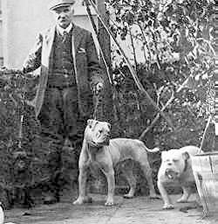 |
 |
||||||||||
| Traditional and engineered bulldogs, 1910 and modern times. The “Perfect Bulldog” would be somewhere in-between, e.g. far right. Which of these represents the true English bulldog and which is the more aesthetically pleasing? |
|||||||||||
 |
|||||||||||
| The word “bygones”
(pronounced “buy gone(s)”) is the plural of
“bygone”, which was first used in popular English literature
in the early 1940’s (Dictionary of Word Origins), and
The concept of ‘bygones’ in the Edwardian era would have referred to the previous Victorian era that began in 1837 and ended in 1901 with the reign and death, respectively, of Queen Victoria. The reign was a long period of prosperity for the British people, an era characterised by a long period of peace and a social system that emphasised morality, self-restraint and properness. From dogs to engineering, the world was becoming obsessed by standards and the rules that defined them. The Bulldog Club defined the ‘perfect’ British Bulldog in a Standard. (Adam Hart-Davis, What the Victorians Did For Us, Headline Publishing, 2001) Sadly, by the time the aforementioned era was so eloquently described a mere century later at the turn of the current century, bulldog breeder’s clubs and their members had, in my humble opinion, managed to nearly completely destroy the perfection that had existed in that golden age, the destruction starting with the compilation and adoption of the compromised second Bulldog Standard by the new Bulldog Club (Incorporated) in the late 1870’s. It is under these dire circumstances that this Bygones Bulldogs research and breeding project has come into being. Our broad and admittedly rather generalised criticisms of the modern English bulldog, will be motivated hereafter. |
|||||||||||
 |
|||||||||||
| Stuart and Lettie Thomson
live on a smallholding in the Garden of Eden forest between
Knysna and Plettenberg Bay on South Africa’s southernmost coast,
known as the “garden route”. Stuart is Director of the Gaia
Research Institute and having after 11 years closed his free
AIDS and cancer clinic a few years ago and completing all current
projects, other than refurbishing a mobile research unit/retirement
motorhome, was pondering a future retirement hobby. Along with
his wife Lettie, the production powerhouse of Gaia Organics,
a range of natural personal care products, then nearing retiring
age, it was decided to pursue a common interest, foremost of
which was their love for English/British Bulldogs. |
|||||||||||
| Stuart with Humphrey & Snowflake, an older type and modern (more show champion pedigreed) bulldog respectively. |
|||||||||||
| Out of this mutual passion for bulldogs arose Bygones, a dedicated bulldog health research and hopefully, breeding project, based on Stuart’s desire to improve the health and functional utility of the breed and Lettie’s tendency to acquire bulldogs. The so-called “modern bulldog” of the 21st Century has deviated so far from the original and traditional bulldogs that existed at the beginning of the 19th and 20th centuries, that it is being increasingly criticised as unhealthy and it’s very existence as inhumane. It is in the face of these challenges that Stuart is partially shifting his institute’s research interests and he and Lettie are contemplating breeding bulldogs in pursuit of the increasingly elusive and controversial “perfect bulldog” (see our informative pages under this title). | |||||||||||
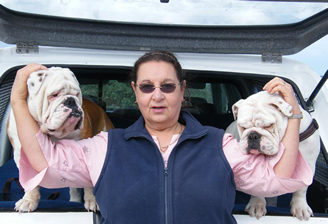 |
|||||||||||
| Lettie with Humphrey and Snowflake. It is hoped that their anticipated offspring will improve the breed. |
|||||||||||
 |
|||||||||||
 |
|||||||||||
| Humphrey
and Snowy 2010 |
|||||||||||
| Our dogs, Humphrey and Snowy
are by no means perfect. Being predominantly white, both are
sun-sensitive (but they don’t overheat as easily). Snowy suffered
from severe ectropion (lower eyelids drooping outwards) as a
newborn pub, but as predicted by a consulting specialist, the
condition resolved as the growing head tightened the facial
tissue. Humphrey especially has excessive facial folds prone
to bacterial overgrowth, but Snowy, with less excessive folds,
is even more prone to bacterial overgrowth because of higher
perspiration rates due to the tendency to obesity in these more
modern dogs. I do believe however, that our dogs are an excellent
basis for a correct change away from the current show-bulldogs
that are shaped like a cross between pigs and walruses. |
|||||||||||
 |
|||||||||||
|
|
|||||||||||
| Humphrey was the runt of his litter, was very thin when acquired and was built up to good condition on a diet of raw milk and eggs and merely defrosted raw beef, chicken and fish, which, with the exception of fish, is still his staple diet, along with some tinned meat, which for some reason he really likes. Snowflake was the giant of her litter and is always hungry. Snowy especially, seems to enjoy eating fresh grass and I break and feed fresh bite-sized clumps daily to both dogs, since traditionally dogs would eat the fermented vegetable matter in the intestine of their herbivorous prey. Snowy has 10 champions in her immediate pedigree (4 never campaigned for conformation) and is as excellent an example of this silly modern bulldog shape as one is able to acquire. Humphrey has 3 champions in his pedigree, but the 11 registered non-champions, who were simply never part of the show circuit, bring such a rich wealth of genetic diversity and highly entertaining character to his pedigree, that in my estimation, he exceeds Snowflake’s high snob-value contribution to the pairing, despite her purchase price being twice that of Humphrey.
A class rift exists within the bulldog fraternity that is not in the best interests of dogs contending for conformation. Breeders and owners of these extreme deviations from the traditional bulldogs are under rather sad delusions that their dogs are superior, when generally the reverse is true, since they fall foul of the far more serious aspects of the hallowed Standard to which both breeders and judges tend to show mere lip-service, such as life-threatening obesity, visually obstructive over-nose-rolls and legs so short that the dogs cannot run or jump as nature intended. Are these realities of which I speak, the reason why breeders clubs, breeders and conformation show contenders are so up in arms over the Kennel Club’s amended Bulldog Breed Standard? Yes indeed, the status quo is at an end. I sympathise with the blind amongst the breeders, but rejoice for the dogs that will benefit over time.
Almost prophetically, certainly timeously, the revised Standard, in the context of the above criticism, now states: “Over nose wrinkle [previously ‘roll’], if present, whole or broken, must never adversely affect or obscure eyes or nose [previously merely “not interfere with the line of the layback”, though under the heading of ‘Eyes’, the Standard did and still does state: “Free from obvious eye problems”. Pinched nostrils and heavy over nose roll are unacceptable and should be heavily penalised.” Also: “Forelegs … short in proportion to hindlegs, but not so short as to make back appear long, or detract from dog’s activity [Previously also “and so cripple him”]. As a relative newcomer/outsider to bulldog shows, these, in addition to the excessive body mass, are the very faults that struck me most amongst the dogs on show, including some winners. |
|||||||||||
| Bertusta Snowflake of Bygones | |||||||||||
| Humphrey is the main attraction
when both are in public together. Snowy is impressive with her
tractor-like physique and polar bear looks, but Humphrey always
gets more praise for his longer, more athletic legs and more readily
discernable classical tapering front to rear ratio that modern
show bulldogs, being too low, too short of limb too and short
and fat, so sadly fail to express. The biggest difference between
my two dogs is the immediately discernable deficiency of agility
in the more modern type. Humphrey tends to delight in effortlessly
running and jumping over obstacles, whilst Snowy waddles and nearly
always stoops to crawl under the same obstacle. Once witnessed,
this difference alone leaves one with no doubt that Humphrey is
the more superior dog of the two. One does not need to be an anatomist
or physiologist to recognise that there are wellbeing deficits
with show bulldogs, which generally tend to be more extreme than
my highly pedigreed, yet relatively moderate Snowflake.
With the increasing emphasis on breeding show-type bulldogs, it is becoming increasingly difficult to acquire a bulldog that is not inbred with most dogs within a specific kennel (line-breeding), and when any outcross occurs, to acquire a dog that was also not also inbred with the same stock from just a few kennels. The circles comprising show breeder’s clubs, members, judges and sponsors, though tense in the face of competition, serve to reinforce the trends to ever greater exaggeration, in particular shorter legs and lower, wider and shorter bodies and encourage this mindless engineering of the breed to the detriment of the health and survival of the dogs themselves, most of whom are too precious or numerous to subject to many of life’s basic pleasures and which circuit ensures that all participants blindly follow these fashion trends to be able to compete for the coveted champion certificates. Being oblivious to their actual superior genetic authenticity, traditional bulldogs are foolishly looked down upon. |
|||||||||||
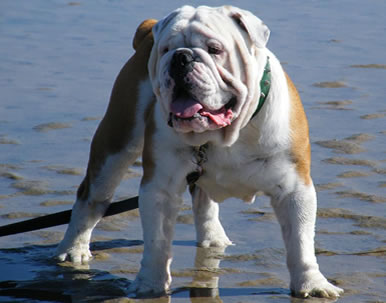 |
|||||||||||
| Humphrey of Bygones | |||||||||||
 |
|||||||||||
| The English bulldog of
today would hardly be recognised by fanciers of the earlier dogs,
which had a specific use, that of bull-holding, which was the
farmer’s method of catching and pinning the bulls for slaughter.
This later developed into the even crueller ‘sports’ of bull-baiting
and bulldog-fighting, eventually forbidden by the Cruelty to Animals
Act of 1835, nearly leading to the extinction of the bulldog.
The first Bulldog Club formed in 1864, but only lasted a few years,
since once bulldogs began appearing in the show-ring, utility
was no longer a primary focus. S Wickens authored the very first
Bulldog Standard (Philo-Kuon), aimed at preserving the ‘traditional’
English bulldog.
Affluent Victorians preferred animals that were different from the more varied functional types kept by commoners. Due to the bulldog’s working class image and disreputable blood-sport origins, commercial breeders concentrated on developing a more aesthetic look by crossings with the Chinese pug, creating a far shorter, lower and wider dog with the now common almost clown-like exaggerated short face “sour-mug” features that became increasingly more like expensive toy-like pets and eventually even status symbols. Accordingly, after the founding of the Kennel Club in 1873, a reconstituted bulldog breed club formed in London in 1875, called the Bulldog Club Incorporated. |
|||||||||||
 |
|||||||||||
| Subsequent standards are responsible
for exaggeration and bulldog’s having difficulty breeding naturally,
requiring conception by artificial insemination and delivery by
caesarian section (Stockman M, The Kennel Club's breed standards,
J Small Animal Practice, 25(9), 1984). The English bulldog
breed is characterised by an abnormal upper airway anatomy, with
enlargement of the soft palate and narrowing of the oropharynx.
During sleep, lengthy and intense episodes of oxygen desaturation
are experienced, causing life-threatening obstructive apnea (suspenion
of breathing) and thereby the systemic hypertension that is largely
responsible for their short lifespans. (Hendricks J et al,
J Appl Physiol, 63(4), 1987); (Saunders N, Sullivan C,
Sleep and Breathing, Informa Health Care, 1994).
Many of the unique physical characteristics of the Bulldog are not physiologically optimal. The degree of selective breeding in its creation makes them prone to many health problems. Bulldogs are prone to entropion, hip dysplasia, dilative cardiomyopathy, medially luxating patella, collapsing trachea, elbow dysplasia, skin allergies, heat sensitivity, progressive retinal atrophy and especially severe breathing difficulties. (Welton R, DVM, English Bulldog, Web-DVM.net, 2007) Bulldogs are now mostly grossly deformed versions of their functional ancestors from whence the legendary attributes of the English Bulldog have become the stuff of legends. Champion show dog breeders tend to perpetuate these health problems and even increase them with every inbred litter produced. I am personally convinced that the abovementioned show dog conformation breeding related respiratory problems and excess weight of these dogs are mainly responsible for the heart failures constituting by far the main cause (20% of total) of premature deaths of these beloved animals. I am also convinced that the proliferation of so-called “veterinary science diet” dry convenience foods, though not bulldog specific, are in addition to bulldog oxygen desaturation, the main cause of the cancers that constitute the second-most cause (18%) of premature bulldog deaths. The third main cause (16%), so-called old age, is a misnomer and just a category for miscellaneous undiagnosed causes of premature deaths, since the lifespan of bulldogs is amongst the shortest of all the breeds. I don’t expect my views as expressed above to win me many, if any friends, but I simply have to put the dogs first. These issues need to be discussed among breeders and bulldog owners, but seldom are. The U.K. Kennel Club survey from which the abovementioned statistics originate, received a dismal 17% response from bulldog breeders. The full Kennel Club Purebred Dog Health Survey for British Bulldogs can be downloaded from our database here. We encourage substantiated, candid, cordial e-mail exchanges from all interested parties around these issues. Contact us here at your earliest convenience. We would like to receive your views and who knows, after deliberation and self-reflection, we may all, dogs included, benefit from the challenges ahead. |
|||||||||||
 |
|||||||||||
| In 1865 members of the original Bulldog Club of Great Britain compiled the first “Standard", an idealised written description of the bulldog. Ten years later and subsequently, the Bulldog Club (then incorporated) had altered the Standard and at one time even raised the maximum weight by 5 lbs (a couple of kgs) in order to match the evolution of the bulldog’s increasingly sedentary lifestyle from one-time working farm and guard-dog to later house pet or show dog. The Standard, or more specifically the increasingly abstract prevailing interpretation thereof, theoretically an ideal specimen that breeders should strive to attain and against which a show judge is supposed to compare each exhibit to select category winners, in reality now seldom matches the dog that it purports to describe. Unauthorised descriptive drawings also falsely legitimise its wayward evolution. | |||||||||||
|
|||||||||||
 |
|||||||||||
| Following much publicity and public and secret debate over a 2008 BBC-TV expose’ of the deteriorating health of many breeds as a result of breeder’s tendency to exaggerate the features described in the standards, the U.K. Kennel Club, the governing body in the country of the bulldog’s origin, embarked on a long overdue review and revision of the Bulldog Standard. In January 2009, the Kennel Club's review led to the introduction of a number of interim amendments, on which Bulldog breeder’s clubs were invited to provide feedback and which, not unsurprisingly, led to emotional fraternity and public resistance campaigns and formal protest submissions aimed at averting any revisions of what was already largely a lip-service Standard. These revisions, 60 in all, and most, if not all of which are perfectly reasonable and in the interests of the dogs themselves, have now been finalised and it just remains to be seen whether national kennel unions will act in the interests of the dogs, by adopting these revised standards, or will pander to the already undue influence of the breeder’s clubs. Breeder’s are obviously reluctant to accept any blame for their malcreations, let alone change direction from the results of decades of toil to their end results. If the revisions are adopted, show breeders will have to follow the revised standards and judges will have to judge by it, but given past disregard for the previous, now fiercely defended Standard, I would not advise holding your breath awaiting sweeping reforms to be effected. |
|||||||||||
| Click here to read
our annotated official revised Bulldog Standard (UK Kennel Club) |
|||||||||||
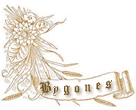 |
Bygones Bulldogs is copyright © 2009. Bygones Bulldogs all rights reserved |
 |
| Page Counter as of December 2009 |
